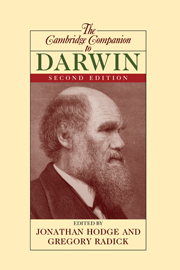Book contents
- Frontmatter
- Introduction
- Part I Darwin’s theorising
- Part II Historical contexts
- 6 Is the theory of natural selection independent of its history?
- 7 Darwin’s science and Victorian philosophy of science
- 8 Darwin and Victorian Christianity
- 9 Darwin, social Darwinism and eugenics
- 10 The place of Darwin’s theories in the intellectual long run
- Part III Current issues
- Part IV Philosphical prospects
- Guide to further reading
- List of references
- Index
7 - Darwin’s science and Victorian philosophy of science
from Part II - Historical contexts
Published online by Cambridge University Press: 28 May 2009
- Frontmatter
- Introduction
- Part I Darwin’s theorising
- Part II Historical contexts
- 6 Is the theory of natural selection independent of its history?
- 7 Darwin’s science and Victorian philosophy of science
- 8 Darwin and Victorian Christianity
- 9 Darwin, social Darwinism and eugenics
- 10 The place of Darwin’s theories in the intellectual long run
- Part III Current issues
- Part IV Philosphical prospects
- Guide to further reading
- List of references
- Index
Summary
Soon after the publication of the Origin of Species (1859), Darwin sent out over a hundred complimentary copies to a variety of contemporaries, including his former geology teacher, Adam Sedgwick. Darwin was prepared for attacks on the content of his theory. What he had not expected were attacks on his methods. Sedgwick, for example, writing in the Spectator in March 1860, complained that 'Darwin's theory is not inductive, - not based on a series of acknowledged facts pointing to a general conclusion, - not a proposition evolved out of the facts, logically, and of course including them. To use an old figure, I look on the theory as a vast pyramid resting on its apex, and that apex a mathematical point.' In other words, for Sedgwick, the problem with the theory of natural selection was that Darwin had not supported it in the right way. The right way was to show that the theory was a generalisation from a wide range of particular facts. That was induction. The wrong way was to invent the theory as a hypothesis and then deduce from it particular facts. That was the method of hypothesis. In Sedgwick's estimation, the theory of natural selection was not an inductive generalisation, but an invented hypothesis, and as such could claim no support from the facts. His image of the pyramid is telling.
- Type
- Chapter
- Information
- The Cambridge Companion to Darwin , pp. 173 - 196Publisher: Cambridge University PressPrint publication year: 2009
- 20
- Cited by

